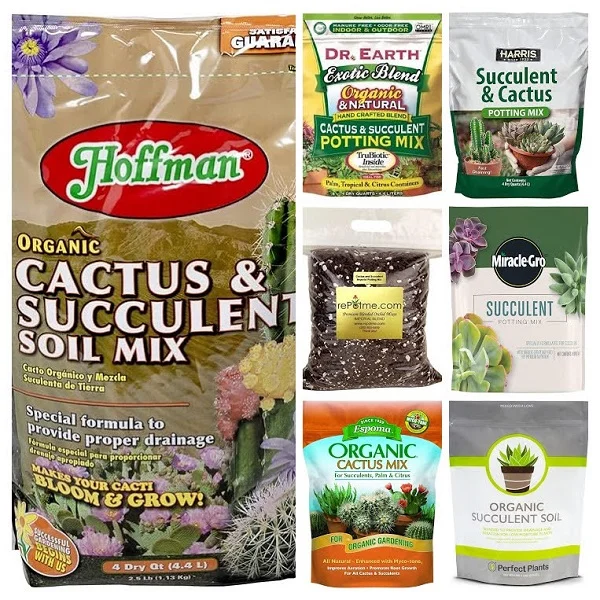30 Succulents that Like Full Sun with Names & Pictures
Some links in this post may be affiliate links
Succulents for full sun are able to withstand drought, heat and hot sun due to their ability to store water in their leaves and or stems.
Not all succulents can tolerate direct sunlight; most succulents will burn under full sunlight. Even those that can withstand full sun require to be protected from hot sunshine to prevent scorching.
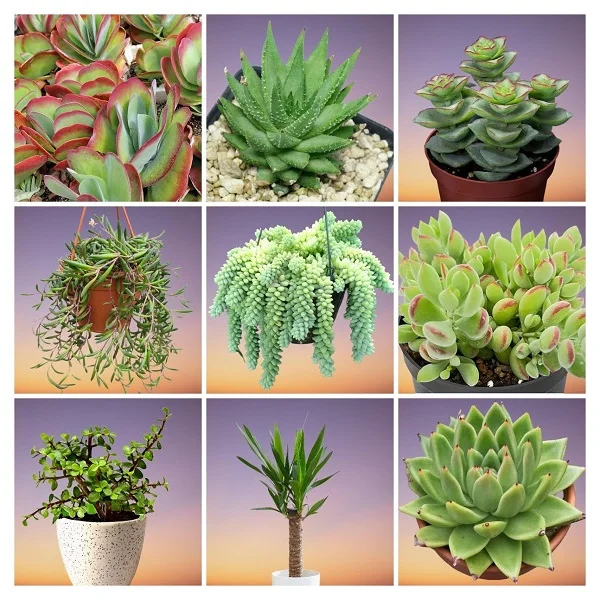
While selecting a spot for these sun tolerant succulents, go for one where the plant is protected from the hot midday sunshine. Such spots like where the trees' or buildings' shade falls on the plants from midday to the early afternoon is ideal for these plants.
Succulents grown in full sun require to be watered differently from those grown indoors. This is because the water evaporates from the soil much faster and the plants loose much more water than those grown indoors.
The succulents in full sun, should be watered more regularly to keep the soil moderately moist in spring and summer and slightly moist in fall and winter. Morning watering is advisable to keep the roots cool through out the day.
Pot these full sun succulents in well-draining soil and a pot with a drainage hole to prevent waterlogging which can lead to rotting, yellowing, leaf loss and eventual death of the plant.
Are you looking for sun loving succulents? We have made it easier for you to make your selection, herebelow is our list of 30 succulents that need direct sunshine to thrive.
30 Direct Sunlight Succulents
Full sun succulents are String of Pearls Plant, String of Nickels Plant, Donkey's Tail Plant, String of Watermelons Plant, Alligator Plant, Snake Plants, Bear's Paw Succulent, Jade Plant, Cacti, Echeveria, Haworthia among others.
1. String of Pearls Plant (Senecio rowleyanus)

String of Beads Plant or String of Pearls Plant is one of the popular Senecio plants varieties that easily adapts to indoor growing conditions and can survive a considerably long period without being watered.
The cascading thread-like stems in String of Pearls Plant make it perfect for a hanging basket, a table-top, a plant shelf or a pedestal where the stems can hang downwards beautifully.
Senecio rowleyanus thrives in bright light with 6-8 hours of direct sunlight, moderate warmth of 20-270C, average humidity of 50-55% and moderately moist, fertile, well-drained succulents soil coupled with monthly feeding during the growing season.
Learn more on how to grow and care for String of Beads Plant (Senecio rowleyanus)
2. String of Nickels Plant (Dischidia nummularia)
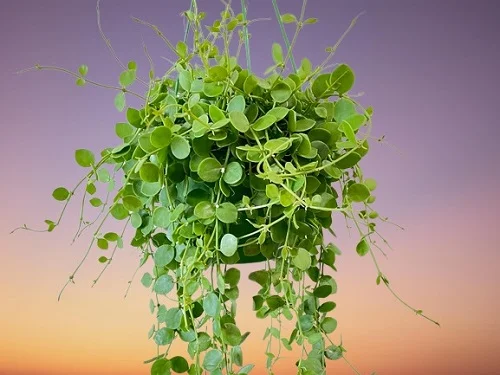
String of Nickels Plant also called Button Orchid is among the popular hanging succulent plants which forms a dense mass of greenish-yellow foliage.
The leaves in Button Orchid are opposite and round and look like numerous coins, hence the common name. The young leaves often have a powdery bloom. The flowers are white to yellowish-white.
Dischidia nummularia requires bright light with 4-6 hours of morning or afternoon sunshine, average warmth of 18-260C, moderate humidity of 50-55% and moderately moist, rich, well-drained succulents soil with two feedings in spring and summer.
Learn more on how to grow and care for String of Nickels Plant (Dischidia nummularia)
3. Donkey's Tail Plant (Sedum morganianum)
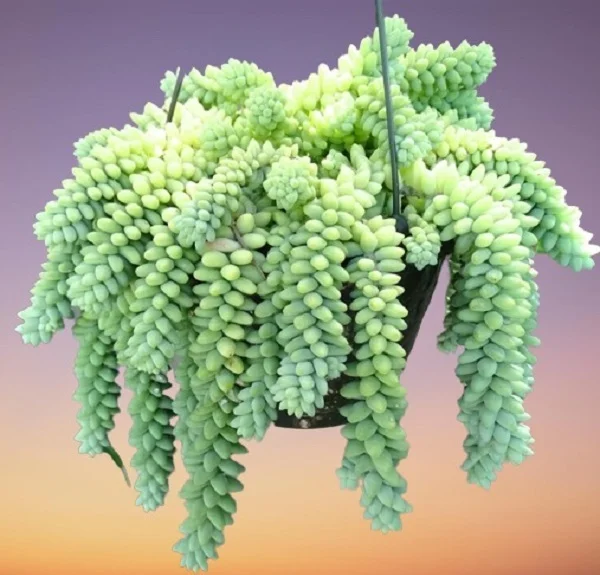
Burro's Tail Plant or Donkey's Tail Plant is a trailing plant which bears 2-3 feet long stems, completely clothed with blue-green cylindrical succulent leaves and is ideal for a hanging basket.
Donkey's Tail Plant grows well in very good light but not extreme heat. To enhance leaf coloration grow the plant in bright light with at least 8 hours of sunshine which makes this plant one of the best sun-loving plants for the home.
Sedum morganianum grows best in bright light with 6-8 hours of direct sunshine, average warmth of 18-260C, moderate humidity of 50-55% and moderately moist, fertile, loose, succulents potting soil coupled with monthly feeding during the growing season.
Learn more on grow and care for Burro's Tail Plant (Sedum morganianum)
4. String of Watermelons Plant (Senecio herreanus)

String of Watermelons Plant also called String of Beads, String of Raindrops or Gooseberryplant is one of the popular Senecio varieties and bears pendant thread-like stems on which are succulent, oval-shaped, dark-green leaves with purple stripes and resemble the rind of the watermelon fruit and hence the common name.
The fleshy leaves and stems store water, which allows the String of Raindrops Plant to go for a considerably long period without being watered which places this plant among the best drought-tolerant plants with low water needs.
Senecio herreanus flourishes in bright light with 4-6 hours of direct sunlight, moderate warmth of 20-270C, average humidity of 50-55% and moderately moist, fertile, well-drained succulents potting mix coupled with monthly feeding in spring and summer.
Learn more on how to grow and care for String of Watermelons Plant (Senecio herreanus)
5. Alligator Plant (Kalanchoe daigremontiana)

Alligator Plant also called Mother of Thousands Kalanchoe, Devil's Backbone Kalanchoe or Mexican Hat Plant is one of the popular Kalanchoe varieties and bears thick, fleshy leaves with numerous bulbils on the teeth which are used to propagate new plants.
On account of their love for sunlight, Mother of Thousands Kalanchoe and its cousins Kalanchoe blossfeldiana (Flaming Katy), Kalanchoe tomentosa (Panda Plant) and Kalanchoe uniflora (Trailing Kalanchoe) are perfect succulents for sunny conditions.
Kalanchoe daigremontiana grows best in bright light to full sunlight, average warmth of 16-260C, moderate humidity of 50-55% and moderately moist, fertile, well-drained succulents soil coupled with monthly feeding during the growing season.
Learn more on how to grow and care for Alligator Plant (Kalanchoe daigremontiana)
6. Snake Plant (Dracaena trifasciata)

Snake Plants also called Mother in-law's Tongue are some of the most popular plants for the home on account of their beautifully colored foliage and ability to clean indoor air.
The Mother-in-law's Tongue Plants are hard to kill plants which can withstand low light, dry air, drafts and periods without water but are prone to root-rot in soggy soil.
Dracaena trifasciata require bright light with 6-8 hours of direct sunlight, average warmth of 16-290C, moderate humidity of 50-55% and moderately moist, loose, fertile, succulents soil coupled with monthly feeding in spring and summer.
Learn more on how to grow and care for Snake Plant (Dracaena trifasciata)
7. Bear's Paw Succulent (Cotyledon tomentosa)

Bear's Paw Succulent also called Bear Claw Succulent or Cat Paw Succulent is among the popular succulent plants which bears large, chunky, ovate, fuzzy, light-green leaves with prominent 'teeth' at the tips which turn deep red in bright light and look-like a bear's claws and hence common name.
Cotyledon tomentosa has two subspecies; Cotyledon tomentosa subs. tomentosa and Cotyledon tomentosa subs. ladismithiensis. The latter is smaller, less branched and bears a brown peeling bark while the former is larger, highly branched and has green hairy branches.
Cotyledon tomentosa blossoms in bright light with at least 4-6 hours of direct sunlight, average warmth of 15-260C, moderate humidity of 50-55% and loose, fast draining soil that is low in organic matter coupled with monthly feeding during the growing season.
Learn more on how to grow and care for Bear's Paw Succulent (Cotyledon tomentosa)
8. Desert Cacti
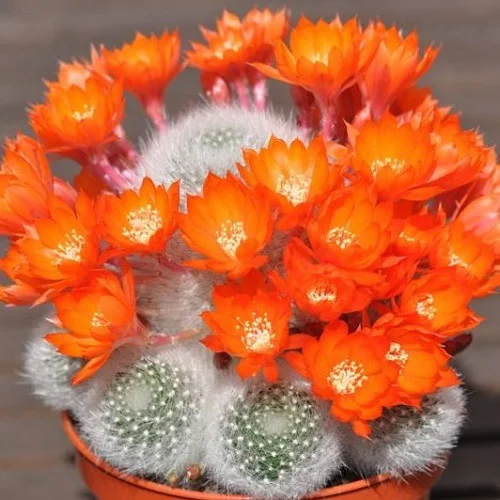
Desert Cacti come in numerous forms and sizes and they form interesting plants which are especially popular with beginners as they can tolerate some level of neglect.
The native habitat of Desert Cacti is subject to drought; many live in extremely dry environments like the Atacama Desert with very bright sunlight. Another group of Cacti are the Forest Cacti which are native to the tropical rain forests. Take a look at these 21 types of cactus plants that are perfect for growing in the home.
Desert Cacti thrive in bright light to full sunlight with at least 2-3 hours of sunshine per day, average warmth of 16-280C, moderate humidity of 50-55% and moderately moist, well drained cactus potting soil coupled with monthly feeding in spring and summer.
Learn more on how to grow and care for Desert Cacti
9. Jade Plant (Crassula ovata)

Crassula ovata is one of the popular Crassula varieties with thick branches and thick, shiny and smooth leaves which grow in opposite pairs along the branch.
The leaves and stems in Jade Plant as in its cousins Crassula arborescens (Silver Dollar Jade), Crassula falcata (Propeller Plant) and Crassula rupestris (Crassula Baby Necklace) are fleshy and store water which allow these plants to go for a considerably long period without being watered making them very drought-tolerant.
Crassula ovata flourishes in bright light with 4-6 hours of direct sunlight, average warmth of 15-260C , moderate humidity of 50-55% and moderately moist, rich, well-drained succulents potting mix coupled with monthly feeding during the growing season.
Learn more on how to grow and care for Jade Plant (Crassula ovata)
10. Haworthia Plants

Haworthia Plants form a rosette of firm, tough, fleshy leaves, usually dark-green in color while others are softer and contain leaf windows with translucent panels through which sunlight can reach internal photosynthetic tissues.
Some popular Haworthias include Haworthia attenuata, Haworthia pumila, Haworthia papillosa, Haworthia fasciata, Haworthia reinwardtii, Haworthia cooperi among others. Check out these 14 Haworthia succulents for the home.
Haworthia thrive in bright light with 6-8 hours of direct sunlight, average warmth of 18-260C, moderate humidity of 50-55% and slightly moist, fertile, well-drained succulents soil coupled with monthly feeding during the growing season.
Learn more on how to grow and care for Haworthia Plants
11. Tree Houseleeks (Aeonium)
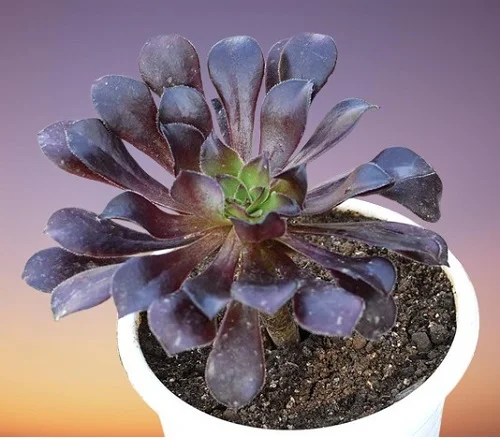
Aeoniums commonly called Tree Houseleeks bear succulent, glossy, spoon-shaped leaves which are typically arranged on a basal stem in a dense spreading rosette and can be low-growing plants or can be large trees.
Tree Houseleeks can be low-growing plants like Aeonium tabuliforme (Flat-topped Aeonium or Saucer Plant) which is about 2 inches high and about 1.5 feet wide or can be large trees like Aeonium arboreum (Tree Aeonium) which can grow to a height of 6-8 feet. Here are 18 Aeonium plants varieties.
Aeoniums will blossom in bright light with at least 4-6 hours of direct sunlight, average warmth of 18-240C, moderate humidity of 50-55% and moderately moist, rich, succulents potting soil coupled with monthly feeding in spring and summer.
Learn more on how to grow and care for Aeoniums
12. Spineless Yucca (Yucca gigantea)

Spineless Yucca also called Blue-stem Yucca, Giant Yucca or Yucca Cane bears a crown of long, leathery, strap-like, spineless leaves and white bell-shaped flowers may appear on mature plants.
Blue-stem Yucca can grow to a height of 8-10 feet when grown indoors. On account of its size, it is one of the favored tree-like plants for the home that will create a bold statement in any space.
Yucca gigantea requires very bright light with 6-8 hours of direct sunshine, average warmth of 16-280C, moderate humidity of 50-55% and moderately moist, rich, well-drained succulents potting mix coupled with monthly feeding during the growing season.
Learn more on how to grow and care for Spineless Yucca (Yucca gigantea)
13. Houseleeks (Sempervivum)
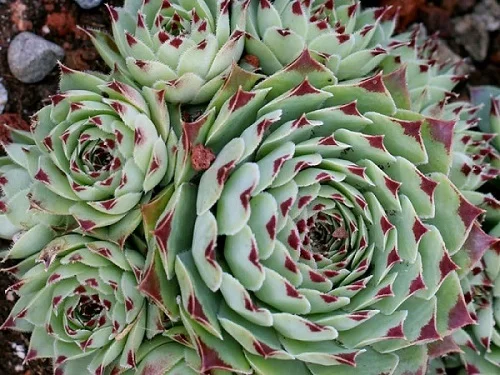
Houseleeks also called Liveforever or Hens and Chicks are popular succulent plants which form mats composed of tufted leaves in rosettes and each plant grows for several years before flowering afterwhich it dies, leaving many offsets (pups) which grow into new plants.
Sempervivums are low-growing, compact plants reaching a height of 4 inches only and each plant grows for several years before flowering. They are some of the best plants for the limited spaces in the home, office and other places.
Sempervivum grow best in bright light with 4-6 hours of direct sunshine, average warmth of 16-280C, average humidity of 50-55% and moderately moist, fertile, well-drained succulents soil coupled with fortnightly feeding during the growing season.
Learn more on how to grow and care for Sempervivums
14. Aloe Plants
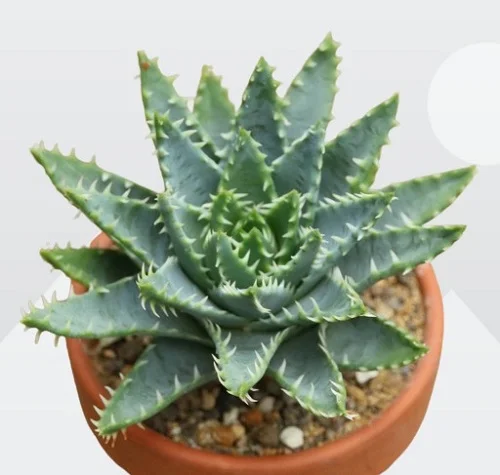
Aloe Plants are popular, succulent plants which form a stemless rosettes of fleshy (succulent) leaves which store water and allows these plants to survive well in drought conditions.
Popular Aloes include Aloe Vera (Aloe barbadensis), Aloe aristata (Lace Aloe), Aloe variegata (Partridge-breasted Aloe), Aloe jucunda, Aloe humilis (Hedgehog Aloe) and Aloe mitriformis among many others. Check out these 15 Aloe succulent plants perfect for growing in the home.
Aloes blossom in bright light with 6-8 hours of direct sunlight, average warmth of 16-280C, moderate humidity of 50-55% and moderately moist, rich, well-drained succulents potting soil coupled with monthly feeding in spring and summer.
Learn more on how to grow and care for Aloe Plants
15. Echeveria Plants

Echeveria Plants are low-maintenance plants which form a rosette of short, beautiful and tightly packed leaves on short stems and are covered with a white bloom, short hairs or a waxy coating making these plants a sight to behold in any space.
Some popular Echeveria Varieties include Plush Plant (Echeveria harmsii), Echeveria amoena, Echeveria carnicolor, Peacock Echeveria (Echeveria desmetiana) and Painted Lady Echeveria (Echeveria derenbergii) among others. Here are 12 Echeveria succulents with names and pictures.
Echeveria Plants thrive in bright light with 4-6 hours of direct sunlight, average warmth of 16-280C, moderate humidity of 50-55% and moderately moist, well-drained succulents soil coupled with fortnightly feeding during the growing season.
Learn more on how to grow and care for Echeveria Plants
16. Thread Agave (Agave filifera)
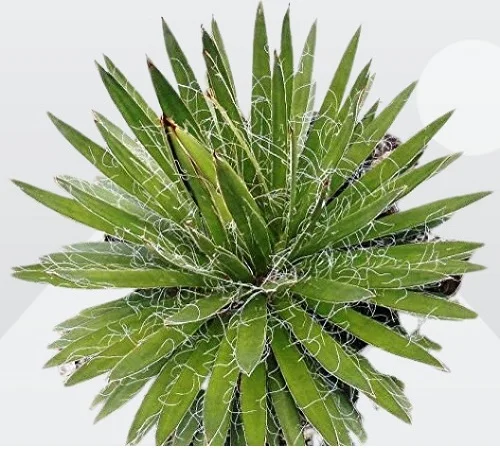
Thread Agave also called Thread-leaf Agave is an evergreen perennial plant and is one of the popular Agave plants grown indoors for its compact size which forms a beautiful, stemless rosette of long, blade-like, dark-green to a bronzish-green colored leaves.
Thread-leaf Agave like Sago Palm (Cycas revoluta) is a loved, compact plant ideal for the small spaces like a sunny balcony.
Agave filifera requires bright light with 6-8 hours of direct sunshine, average to above average warmth of 21-320C, moderate humidity of 50-55% and moderately moist, rich, well-drained succulents soil coupled with monthly feeding during the growing season in the first 2 years of growth.
Learn more on how to grow and care for Thread Agave (Agave filifera)
17. Teddy Bear Vine (Cyanotis kewensis)
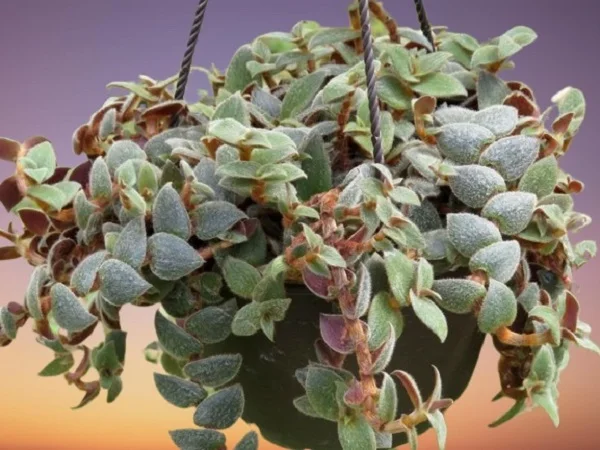
Teddy Bear Vine is a popular succulent vine which bears oval-shaped, hairy (velvet-like) leaves with purple undersides and mauve, blue-violet or pinkish-purple flowers.
The Teddy Bear Vine is a slow growing plant whose stems beautifully cascade downwards which places it among the best plants for hanging baskets and limited spaces like an office desk, sunny balcony among others.
Cyanotis kewensis prospers in bright light with 4-6 hours of morning sunshine, average warmth of 15-270C, moderate humidity of 50-55% and moderately moist, rich, succulents mixes and regular feeding in spring and summer.
Learn more on how to grow and care for Teddy Bear Vine (Cyanotis kewensis)
18. Sunglow Plant (Red Crassula)
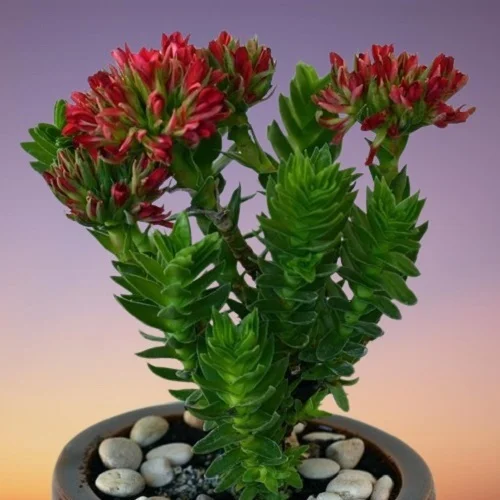
Sunglow Plant or Red Crassula is a neat succulent plant whose stems are clothed with leathery triangular leaves which look like they are stacked on top of each other.
Sunglow Plant grows to a height of about 1-1.5 feet and bears showy clusters of red tubular flowers. On account of its compact size, Red Crassula like Crassula ovata (Jade Plant), Crassula picturata (Tiger Jade Crassula) and Crassula elegans (Elegant Crassula) is among the best plants for the limited spaces.
Crassula coccinea blossoms in bright light with 4-6 hours of direct sunlight, average warmth of 15-240C, moderate humidity of 50-55% and moderately moist, fertile, well-drained succulents soil coupled with monthly feeding during the growing season.
Learn more on how to grow and care for Sunglow Plant (Crassula coccinea)
19. String of Rubies Plant (Othonna capensis)

String of Rubies Plant also called String of Pickles, Little Pickles or Ruby Necklace is among the string of plants and bears reddish-purple stems and bean-shaped leaves which turn a bright ruby red when the plant is grown under bright sunshine.
The String of Pickles Plant grows as a trailer, with stems trailing which are spectacular when they cascade downwards beautifully in a hanging basket or on a pedestal.
Othonna capensis flourishes in very bright light with at least 6 hours of sunshine, average warmth of 20-270C, moderate humidity of 50-55% and moderately moist, fertile, well-drained succulents soil coupled with two feedings during the growing season.
Learn more on how to grow and care for String of Rubies Plant (Othonna capensis)
20. String of Buttons Plant (Crassula perforata)
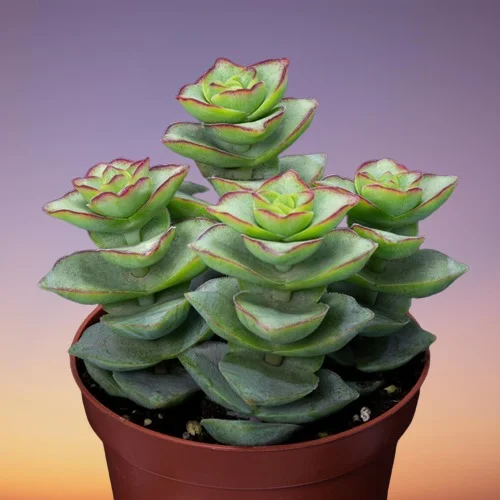
String of Buttons Plant is an easy-care, shrubby, succulent plant which bears triangle-shaped, gray-green leaves with a rosy pink hue along the edges in bright light.
String of Buttons Plant like Crassula brevifolia (Crassula pearsonii), Crassula tomentosa (Woolly Crassula) and Crassula cotyledonis (Crassula dubia) is best watered by the 'soak and dry' method which requires a thorough soaking of the soil followed by a drying out of the soil before the next watering.
Crassula perforata thrives in bright light with 4-6 hours of direct sunlight, average warmth of 15-260C, moderate humidity of 50-55% and loose, well-drained succulents soil that is low in organic matter coupled with monthly feeding in spring and summer.
Learn more on how to grow and care for String of Buttons Plant (Crassula perforata)
21. Gasteria Plants
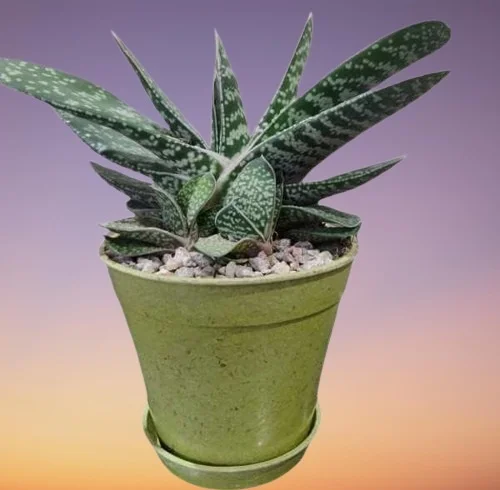
Gasteria Plants are recognizable from their thick, hard, succulent 'tongue-shaped' leaves and hence their common names Ox-tongue, Cow-tongue, Lawyer's Tongue and occasionally Mother-in-law's Tongue.
The leaves in Gasteria may be warty like in Gasteria verrucosa or smooth like in Gasteria maculata. The color of leaves in Gasteria vary from dark-green to light-green. Some are spotted with light shades of green or grey-green. Many hybrids have been developed like, Gasteria bicolor which features thick, flat leaves with striped patterns. Check out these 12 Gasteria succulent plants for the home.
Gasteria flourish in bright light with 6-8 hours of direct sunshine, average warmth of 18-290C, moderate humidity of 50-55% and moderately moist, fertile, well-drained succulents potting mix coupled with monthly feeding in the growing season.
Learn more on how to grow and care for Gasteria Plants
22. String of Dolphins Plant (Senecio peregrinus)
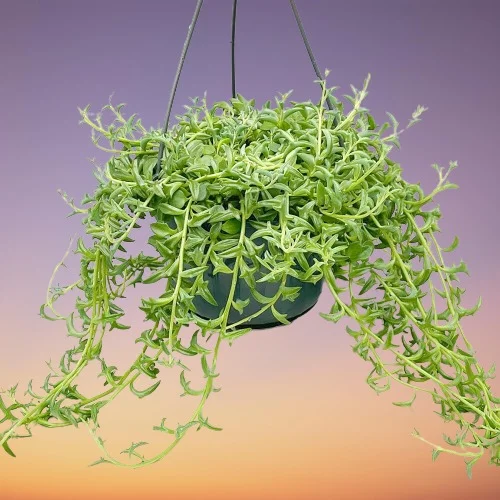
String of Dolphins Plant also called Dolphin Necklace, Flying Dolphins or Dolphin Plant bears pendant thread-like stems on which curvy leaves with two small points grow and look like a pod of flying or jumping dolphins and hence the common name.
The fleshy leaves and stems in String of Dolphins Plant like in String of Bananas Plant (Senecio radicans) store water, which allows it to go for a considerably long period without being watered.
Senecio peregrinus blossoms in bright light with 4-6 hours of direct sunlight, moderate warmth of 20-270C, average humidity of 50-55% and moderately moist, fertile, well-drained succulents potting soils coupled with monthly feeding during the growing season.
Learn more on how to grow and care for String of Dolphins Plant (Senecio peregrinus)
23. String of Turtles Plant (Peperomia prostrata)
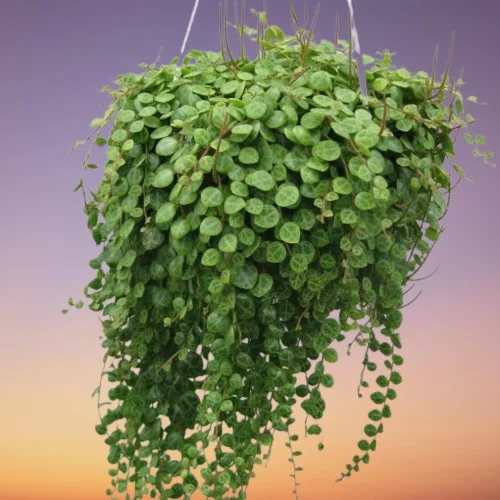
String of Turtles Plant also called Magic Marmer is among the compact, perennial, trailing Peperomia plants varieties that easily adapts well to indoor growing conditions and is ideal for a hanging basket, a pedestal, a desktop or a tabletop.
Magic Marmer bears succulent leaves about 1 inch long, heart-shaped with beautiful patterns of white veins which vary in color from maroon to dark blue to purple in young plants and they become silvery-white as the plant matures.
Peperomia prostrata grows best in bright light with 4-6 hours of direct sunlight, average warmth of 18-250C, humidity of 50-55% and moderately moist, fertile, well-drained, succulents potting mix coupled with monthly feeding in spring and summer.
Learn more on how to grow and care for String of Turtles Plant (Peperomia prostrata)
24. Jelly Beans Plant (Sedum rubrotinctum)
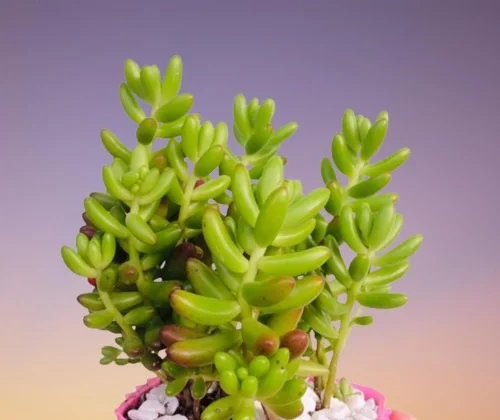
Jelly Beans Plant also called Pork and Beans Plant bears short succulent leaves about 1/2 inches long that resemble jelly beans and change color from green to red in bright light as a protective adaptation.
Like in Sedum pachyphyllum (Blue Jelly Beans Plant), the stems in Jelly Beans Plant are upright in young plants but they eventually grow long enough to trail over the sides of the pot, creating a hanging plant display and making these plant some of the best hanging succulents.
Sedum rubrotinctum flourishes in bright light to full sunlight, average warmth of 18-260C, moderate humidity of 50-55% and moderately moist, rich, loose, succulents potting soil coupled with monthly feeding during the growing season.
Learn more on how to grow and care for Jelly Beans Plant (Sedum rubrotinctum)
25. String of Lemons Plant (Senecio citriformis)

String of Lemons Plant also called String of Tears Plant or String of Teardrops Plant is among the favorite plant which bears erect stems on which grow oval, succulent, green to dark-green, teardrop-shaped or lemon-shaped leaves.
The fleshy leaves and stems store water, which allows the plant to go for a considerably long period without being watered. On account of its compact size, drought tolerance and requirement for bright light with exposure to some direct sunshine, String of Teardrops Plant is one of best low-maintenance plants for a sunny balcony.
Senecio citriformis performs best in bright light with 4-6 hours of direct sunlight, moderate warmth of 20-270C, average humidity of 50-55% and moderately moist, fertile, well-drained succulents soils coupled with monthly feeding in spring and summer.
Learn more on how to grow and care for String of Lemons Plant (Senecio citriformis)
26. Paddle Plant (Kalanchoe thyrsiflora)

Paddle Plant also called Desert Cabbage, FlapJack or White Lady is a popular Kalanchoe foliage plant on account of its beautiful foliage which is a basal rosette of large, rounded, succulent, stalkless, grayish-green leaves with red margins under bright light and covered with a white powdery bloom.
Like other Kalanchoe plants varieties, FlapJack contains Calcium glycosides which are toxic to animals as indicated by ASPCA. Keep it away from the reach of pets to avoid any mishaps.
Kalanchoe thyrsiflora prospers in bright light to full sunlight, average warmth of 16-260C, moderate humidity of 50-55% and moderately moist, rich succulents soil coupled with monthly feeding in the growing season.
Learn more on how to grow and care for Paddle Plant (Kalanchoe thyrsiflora)
27. Crassula capitella 'Campfire'

Crassula capitella 'Campfire' commonly called Crassula Campfire, Campfire Crassula or Red Flames Plant is a perennial succulent with propeller-like, flesh leaves which start off light-green and become a bright reddish color in bright light.
The fleshy leaves and stems in Campfire Crassula store water which allow the plant to go for a considerably long period without being watered and make this plant one of the low-maintenance plants for the home, office and any suitable place.
Crassula capitella 'Campfire' flourishes in bright light with about 4-6 hours of direct sunlight, average warmth of 15-260C, moderate humidity of 50-55% and moderately moist, rich, well-drained succulents soil coupled with monthly feeding in spring and summer.
Learn more on how to grow and care for Crassula capitella 'Campfire'
28. Panda Plant (Kalanchoe tomentosa)

Panda Plant is a succulent plant which bears silvery-green, brown-edged furry or woolly leaves and hence its other common names; Pussy Ears and Chocolate Soldier.
Pussy Ears Kalanchoe like Kalanchoe marmorata (Penwiper Plant) is one of the popular plants for limited spaces on account of its compact size.
Kalanchoe tomentosa blossoms in bright light to full sunlight, average warmth of 16-260C, moderate humidity of 50-55% and moderately moist, fertile, well-drained succulents potting mix coupled monthly feeding during the growing season.
Learn more on how to grow and care for Panda Plant (Kalanchoe tomentosa)
29. Blue Chalksticks Plant (Senecio serpens)

Blue Chalksticks Plant also called Dead Man's Fingers is a low-growing plant which bears fleshy, cylindrical, powdery, blue-green leaves on a prostrate stem.
On account of its drought tolerance and requirement for bright light with exposure to some direct sunshine, Blue Chalksticks Plant like Barberton Groundsel (Senecio barbertonicus) is one of the best plants for full sun conditions.
Senecio serpens thrives in bright light with 4-6 hours of direct sunlight, average warmth of 20-270C, moderate humidity of 50-55% and moderately moist, loose, rich, well-drained succulents soil coupled with monthly feeding in spring and summer.
Learn more on how to grow and care for Blue Chalksticks Plant (Senecio serpens)
30. Moonstones Plant (Pachyphytum oviferum)
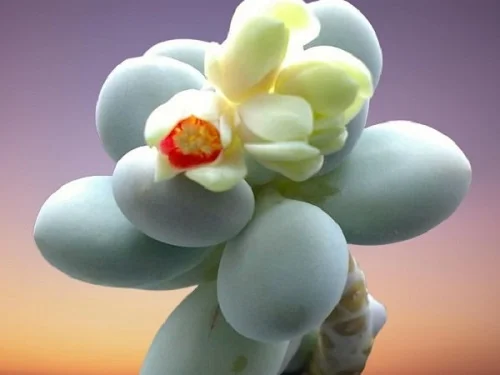
Moonstones Succulent also called Sugar Almond Plant is a succulent with pale blue-green to bluish-purple, egg-shaped leaves and look-like a sugared almond confection and hence the name, 'Sugar Almond'.
Sugar Almond Plant can grow to a height of about 6 inches and a spread of 1 ft and the white stems bear up to 15 leaves each. Like Silver Dollar Jade (Crassula arborescens), it is ideal for the limited spaces like a sunny balcony.
Moonstones Succulent (Pachyphytum oviferum) prospers in bright light to full sunlight, average warmth of 16-260C, moderate humidity of 50-55% and moderately moist, well-drained succulents soil coupled with quarterly feeding during the growing season.
Learn more on how to grow and care for Moonstones Succulent (Pachyphytum oviferum)
